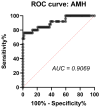Evaluation of Biochemical Serum Markers for the Diagnosis of Polycystic Ovary Syndrome (PCOS) in Obese Women in Kazakhstan: Is Anti-Müllerian Hormone a Potential Marker?
- PMID: 39457645
- PMCID: PMC11504444
- DOI: 10.3390/biomedicines12102333
Evaluation of Biochemical Serum Markers for the Diagnosis of Polycystic Ovary Syndrome (PCOS) in Obese Women in Kazakhstan: Is Anti-Müllerian Hormone a Potential Marker?
Abstract
Background: Polycystic Ovarian Syndrome (PCOS) is a common endocrine condition that affects 8-13% of women of reproductive age. In Kazakhstan, the prevalence of this syndrome is particularly high compared with other countries and the global average. Currently, the diagnosis of PCOS is based on internationally established Rotterdam criteria, using hyperandrogenism as a key parameter. These criteria are applied to diagnose PCOS in all female patients, although obese patients may have excess testosterone produced by adipose tissue. To avoid possible misdiagnosis, an additional criterion, especially for the diagnosis of PCOS in obese women, could be considered. The aim of this study was to identify whether anti-Müllerian hormone (AMH) or other biochemical criteria can be used for this purpose. Methods: A total of 138 women were recruited for this study and grouped into control (n = 46), obese subjects without PCOS (n = 67), and obese patients with PCOS (n = 25). The health status, anthropometric parameters, and serum indicators for glucose, glycosylated hemoglobin, and hormone levels were examined for all subjects. Statistical data were analyzed using GraphPad Prism 10 software for interpretation of the data. Results: Serum AMH, testosterone, and LH were positively correlated in obese PCOS patients, while AMH and FSH were negatively correlated. Compared with other biochemical indicators, the serum AMH and testosterone levels in obese PCOS patients were significantly higher than those in non-PCOS patients (regardless of obesity), and AMH was also positively correlated with testosterone. Conclusions: AMH appears to be a reliable criterion in addition to testosterone for the diagnosis of PCOS in obese women.
Keywords: anti-Müllerian hormone (AMH); biomarker; hyperandrogenism; obesity; polycystic ovary syndrome (PCOS).
Conflict of interest statement
The authors declare no conflicts of interest.
Figures






Similar articles
-
[Serum levels of anti-muller hormone in women with polycystic ovary syndrome and healthy women of reproductive age].Akush Ginekol (Sofiia). 2013;52 Suppl 1:16-23. Akush Ginekol (Sofiia). 2013. PMID: 24294740 Bulgarian.
-
The prevalence of polycystic ovary syndrome in a normal population according to the Rotterdam criteria versus revised criteria including anti-Mullerian hormone.Hum Reprod. 2014 Apr;29(4):791-801. doi: 10.1093/humrep/det469. Epub 2014 Jan 16. Hum Reprod. 2014. PMID: 24435776
-
Accuracy of anti-Müllerian hormone and total follicles count to diagnose polycystic ovary syndrome in reproductive women.Taiwan J Obstet Gynecol. 2018 Aug;57(4):499-506. doi: 10.1016/j.tjog.2018.06.004. Taiwan J Obstet Gynecol. 2018. PMID: 30122568
-
Anti-Müllerian hormone levels in the diagnosis of adolescent polycystic ovarian syndrome: a systematic review and meta-analysis.Endocr J. 2022 Aug 29;69(8):897-906. doi: 10.1507/endocrj.EJ22-0081. Epub 2022 Jun 8. Endocr J. 2022. PMID: 35675999
-
The Role of Serum Anti-Mullerian Hormone Measurement in the Diagnosis of Polycystic Ovary Syndrome.Diagnostics (Basel). 2023 Feb 27;13(5):907. doi: 10.3390/diagnostics13050907. Diagnostics (Basel). 2023. PMID: 36900051 Free PMC article. Review.
Cited by
-
Exploring zinc-α2-glycoprotein as a mediator of infertility in polycystic ovarian syndrome: a comparative study from a metabolic perspective.Prz Menopauzalny. 2025 Jun;24(2):120-125. doi: 10.5114/pm.2025.152414. Epub 2025 Jun 30. Prz Menopauzalny. 2025. PMID: 40777873 Free PMC article.
References
-
- Miazgowski T., Martopullo I., Widecka J., Miazgowski B., Brodowska A. National and regional trends in the prevalence of polycystic ovary syndrome since 1990 within Europe: The modeled estimates from the Global Burden of Disease Study 2016. Arch. Med. Sci. 2021;17:343–351. doi: 10.5114/aoms.2019.87112. - DOI - PMC - PubMed
LinkOut - more resources
Full Text Sources

